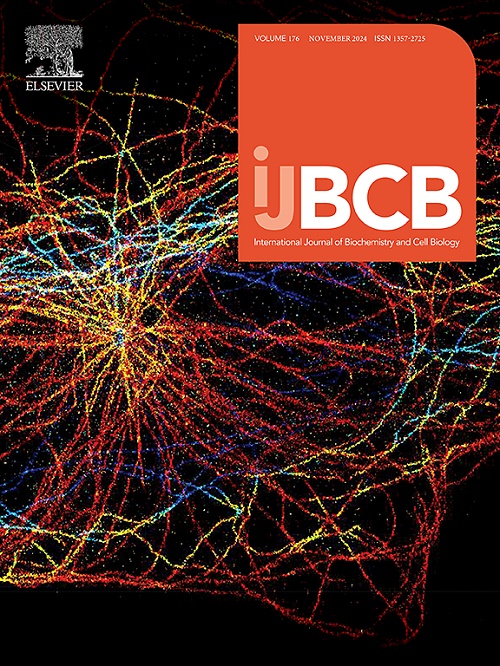SPDYE3 promotes cell cycle and LUSC progression by regulating the CDC25C/CDK1 pathway
IF 2.8
3区 生物学
Q2 BIOCHEMISTRY & MOLECULAR BIOLOGY
International Journal of Biochemistry & Cell Biology
Pub Date : 2025-06-26
DOI:10.1016/j.biocel.2025.106825
引用次数: 0
Abstract
Background
Lung cancer is the primary reason for global cancer-related deaths. Targeted therapy is currently absent for lung squamous cell carcinoma (LUSC), a significant pathological subtype of lung cancer. The gene SPDYE3, a member of the Speedy/Ringo gene family, is highly expressed in different cancer tissues and functions as a cell cycle regulator. However, the potential mechanisms and clinical significance of SPDYE3 in LUSC remain unknown.
Method
Gene chip technology was used to detect the expression profiles of RNA in saliva, plasma, and normal controls of LUSC patients. Real-time quantitative polymerase chain reaction(qRT-PCR) was utilized to examine the expression and significance of SPDYE3 in the early diagnosis of LUSC. Furthermore, additional experiments were performed in vitro and in vivo to further assess the impact of SPDYE3 on the proliferation and cell cycle of LUSC. Further investigations were performed using IP, mass spectrometry analysis, and Western blotting to explore the interaction between SPDYE3 and cell division cycle 25 C (CDC25C).
Result
Our data showed that SPDYE3 is upregulated in LUSC tissues, plasma, and cells. SPDYE3 exhibited diagnostic usefulness, achieving an Area Under the Curve (AUC) of 0.7288. Experiments conducted in vitro and in vivo revealed that SPDYE3 enhances the growth and advancement of the cell cycle in LUSC cells. SPDYE3 mechanistically stimulates the activation of cyclin-dependent kinase 1 (CDK1) and controls the advancement of the cell cycle by interacting with CDC25C.
Conclusion
Overall, our results support the novel regulatory role of SPDYE3 in LUSC cell cycle progression mechanisms by influencing the CDC25C/CDK1 signaling pathway.
SPDYE3通过调节CDC25C/CDK1通路促进细胞周期和LUSC进展
肺癌是全球癌症相关死亡的主要原因。肺鳞状细胞癌(LUSC)是一种重要的肺癌病理亚型,目前缺乏靶向治疗。spdye基因是Speedy/Ringo基因家族的一员,在不同的癌症组织中高度表达,并具有细胞周期调节作用。然而,SPDYE3在LUSC中的潜在机制和临床意义尚不清楚。方法采用基因芯片技术检测LUSC患者唾液、血浆及正常对照中RNA的表达谱。采用实时定量聚合酶链反应(Real-time quantitative polymerase chain reaction, qRT-PCR)检测SPDYE3在LUSC早期诊断中的表达及意义。此外,我们还进行了体外和体内实验,进一步评估SPDYE3对LUSC增殖和细胞周期的影响。利用IP、质谱分析和Western blotting进一步研究SPDYE3与细胞分裂周期25 C (CDC25C)之间的相互作用。结果SPDYE3在LUSC组织、血浆和细胞中表达上调。SPDYE3具有诊断价值,曲线下面积(AUC)为0.7288。体外和体内实验表明SPDYE3能促进LUSC细胞的生长和细胞周期的推进。SPDYE3通过与CDC25C相互作用,刺激细胞周期蛋白依赖性激酶1 (cyclin-dependent kinase 1, CDK1)的活化,控制细胞周期的推进。总之,我们的研究结果支持SPDYE3通过影响CDC25C/CDK1信号通路在LUSC细胞周期进程机制中的新调控作用。
本文章由计算机程序翻译,如有差异,请以英文原文为准。
求助全文
约1分钟内获得全文
求助全文
来源期刊
CiteScore
8.10
自引率
0.00%
发文量
124
审稿时长
19 days
期刊介绍:
IJBCB publishes original research articles, invited reviews and in-focus articles in all areas of cell and molecular biology and biomedical research.
Topics of interest include, but are not limited to:
-Mechanistic studies of cells, cell organelles, sub-cellular molecular pathways and metabolism
-Novel insights into disease pathogenesis
-Nanotechnology with implication to biological and medical processes
-Genomics and bioinformatics

 求助内容:
求助内容: 应助结果提醒方式:
应助结果提醒方式:


